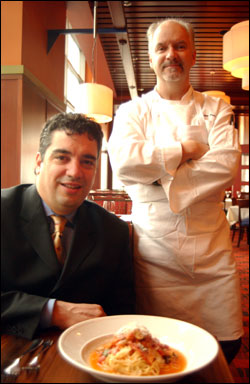At about half past 7, things were beginning to fray at the edges at Troiani. It was only the second night open at the new Italian place at Third Avenue and Madison Street, and something like 200 invited guests had breezed in over the course of half an hour, ready to eat and drink and schmooze. By 8 o’clock, waitstaff were wandering around with the stunned look of earthquake victims, oblivious to the freeloaders waving and pointing to their empty plates; the restaurant manager was rushing from table to table pouring wine; the owner-CEO of the operation was seen slicing baguettes to stay the hunger of his increasingly ravenous guests.
From time to time, though, a plate managed to make it out of the kitchen and to a table, and when it did, it was instantly clear that if everyone in the dining room was on the verge of losing their heads, the kitchen was emphatically keeping its cool. The food was perfectly cooked, beautifully presented, and delicious. Even those, like my date and I, who left (at about 9 p.m.) before desserts had begun to emerge went home impressed. And we’ve only grown more impressed with every subsequent visit.
IN SOME WAYS, Troiani is a throwbacka restaurant in the grand manner: big, simply but grandly appointed, and unashamedly aimed at a clientele that appreciates good food but is more interested in substance than filigree, and is willing to pay to get it. Nor, in Seattle, has anybody put his name over the door quite so emphatically as Rich Troianinot, at least, since the days of Victor Rosellini, whose legendary restaurants catering to the Seattle power elite Troiani clearly aims to emulate.
In a way, that’s not surprising. Much of the money behind Troiani comes from Paul Mackay, who proved when he opened El Gaucho on First Avenue that he could not only revive a legendary Seattle restaurant name but make its retro-steak house formula work in the hard-sell atmosphere of the 1990s. Troiani takes the stage in a far more difficult era economically, but Mackay and his collaborators, manager Troiani and chef Walter Pisano, clearly believe there’s a place for neo-Rosellini dining downtown.
Troiani’s lunch menu is distinctly workday oriented and priced to suit, with a classy stand-alone salad of seared tuna, fennel, and pickled vegetables ($13); pancetta-arugula hard-boiled egg panini ($10); and a trio of bruschettassurfy, turfy, and veggiefor just $9. A fabulous cioppino comes in at $13; the priciest item on the bill of fare is a very substantial serving of New York steak at $24.
THE DINNER LINEUP is far more assertive and requires more study: You may have a little difficulty getting leisure to study it, because Troiani’s staff is almost unstoppably determined to explain every single item to you ingredient by ingredient. It’s not all that complicated, really, if you keep in mind that the pasta courses are essentially appetizer-size; nobody’s going to spoil their appetite ordering the single ricotta-spinach “raviolo” in fragrant porcini broth ($12) before a main dish, though a full plate of the nontraditional fluffy ricotta gnocchi in a parsley puree ($10) might end up cloying a solo diner.
Among the appetizers proper, the grilled calamari in tomato-mint vinaigrette ($10) is three-bites-and-it’s-gone; likewise the bite-sized crispy sweetbread and winter squash chunks zinged up with grilled shallots in a sweet-sour sauce ($12), a hit even with diners who don’t want to know what sweetbreads are or where they come from. Opinion was divided on a little bowl of rich winter- vegetable puree studded with (shell-less) garlic clams reminiscent of escargots ($9), but I thought it was dandy and finished every bite. There was something decidedly odd about the basil-cured tuna ($13); it was gelatinous and tasted cured in something far more vinegary than basil.
There was no need to quibble over any main dish. Avoiding the tableside-carved spectacle of “Steak Troiani” (“New York strip filled with salame cotto and fontina,” $85 for two), we opted for less budget-bruising items: a perfect rib chop scented with rosemary ($34); a hefty four-chop rack of lamb ($36) served over crispy deep-fried baby artichokes and grilled onions; an extraordinary preparation of duck ($26), the leg and thigh meltingly tender, the breast properly crisp and rare; and, even more satisfying and reasonably priced, a whole falling-off-the-bone tender braised pork shank ($21).
The ࠬa carte side vegetables (mostly $6) also scored high: bitter broccoli rabe with a sprinkle of garlic breadcrumbs, a dish of creamy polenta lightly flavored with sweet-potato puree, and lovely whipped potatoes flavored with pine nuts. It’s hard to imagine anyone with room to indulge in a post-prandial Italian cheese board ($10 for three samples, $12 for five, $15 for seven) or even dessert (all $7), though we did manage to share a chocolate-orange semifreddo on one visit and an enormous three-scoop serving of gelati from Gelatiamo down the street.
Apart from that initial overattentiveness, service at Troiani is as impressive as what’s served. The wine list, strongly Italian- accented, is definitely on the big-ticket side, but an extensive by-the-glass selection lets one find the right wine for each dish without breaking the bank. The bar is ready to provide anything in the cocktail line, with specials ranging from a bubbly peach Bellini to a killer whiskey sour (both $8). Troiani, to sum up, is already conducting itself like the Seattle institution it proposes to be. And I say, long may it wave.








